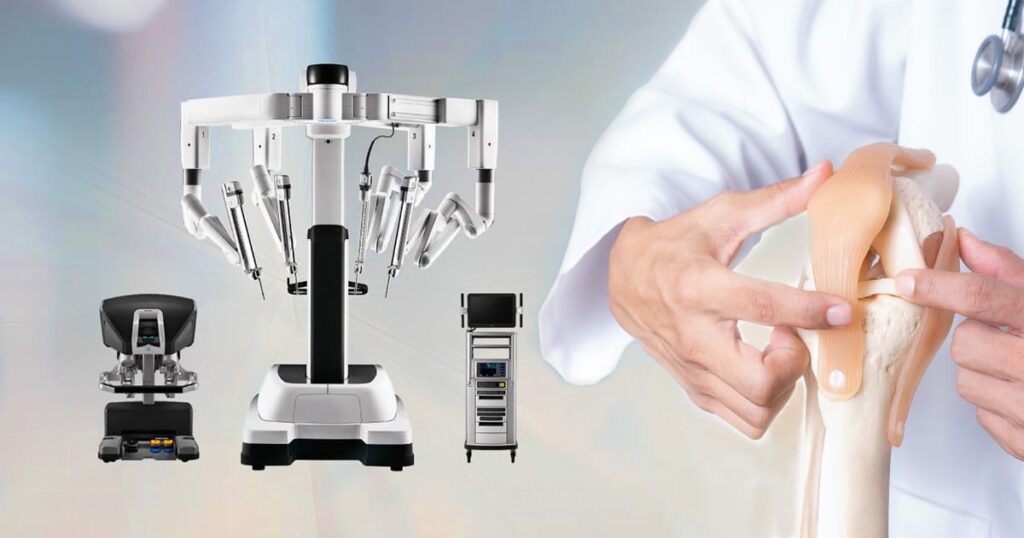Robotic-Assisted Knee Replacement Surgery: Joint Care Reformed
The painful knee is a worldwide burden that affects millions, with limited mobility due to continuous pain and poor quality of life. For many years, total knee arthroplasty has remained the reference surgical approach in treating knee pathologies that have serious deterioration processes. However, with recent medical technological advancement, the alternative has become more accurate and effective: Robotic knee replacement surgery makes interaction with patients more available than in traditional knee replacement surgeries. This new surgical procedure offers an attractive solution to those people who live with debilitating knee diseases through better accuracy, shorter downtime, and better patient outcome guarantees.
Knee Replacement Surgery: How It Works
First, it is of paramount importance to consider the general outline of knee replacement surgery to then go into the specifics related to the robotic knee replacement procedure. The surgical intervention of replacing a faulty knee joint uses a prosthesis. This is mainly done to relieve pain and improve the quality of the knee joint so that the patient will be in a good position to perform daily activities with less pain.
Surgery for knee replacement is the last option that is usually availed by those people who have severe arthritis, and this could be due to osteoarthritis, rheumatoid arthritis, or even post-traumatic arthritis. Due to such conditions in the knee joint, the cartilaginous tissues wear out, which causes the rubbing of bones with each other leading to inflammation and sharp pain. For such conditions, when all other conventional modes of treatment, drugs, physical therapy, and changes in diet and activity patterns don’t work, then knee replacement surgery is one solution that can be investigated.
Key Differences Between Traditional and Robotic Knee Replacement
This is quite different from the traditional knee replacement operation, where the orthopedic surgeon jacks and roughens the bones, and then trims and cuts out the damaged tissue to accommodate a prosthesis. This has however not been without its drawbacks as will be discussed in the following section. One disadvantage of the method is that the implant positioning is very subjective, depending on the proficiency of the surgeon, which produces certain variability in patient outcomes.
This is where Robotic knee replacement surgery comes in. In contrast to the conventional technique of knee replacement surgery, robotic-assisted knee replacement employs the use of robotics and imaging in the process to enhance the work of surgeons while conducting surgery.
How Robotic Knee Replacement Surgery Works
Similar to any other surgery, robotic knee replacement includes preoperative evaluation and assessment through radiographic imaging with the help of CT scans or MRIs. This results in obtaining stereo-images that build a three-dimensional picture of the knee joint of the patient in need of surgery, and as a result, the surgeon prepares an individual approach towards the surgery based on the particularities of the specific anatomical features of the patient. From this plan, one can establish the size, the type, and the alignment of the implant.
In the actual surgery, it helps the surgeon carry out the plan with remarkable dexterity. During surgery, the surgeon uses a special arm of the robot that drills precise cuts into the bone and also accurately places implants with an accuracy of up to 0.1 millimeters. This would entail such precision that the implanting materials are shaped to the patient’s knee and move in the same pattern as the remaining healthy part of the knee to eliminate the complications that may occur with future uses of the knee joint.
Benefits of Robotic Knee Replacement Surgery
·Improved Precision and Accuracy: Knee robotic surgery is a definite option for undergoing knee replacement rather than the traditional method. This is possible because the manipulations of the robotic system can provide more precise cuts on the bone and better positioning of the implants than is currently possible by conventional means. This precision cuts down on the amount of stress placed on the implant, which may increase its useful life.
·Personalized Surgical Approach: Robotic-assisted surgery is beneficial for the patient since the operations can be done individually and adjusted to the specific shape of the organism. In this way, the knee joint is covered with a very accurate three-dimensional model, thereby aiding the surgeon when preparing for the operation.
Reduced Risk of Complications: The stability of the implant is greatly dependent on the correct placement of the implant as implant instability, instability, and dislocation are some of the complications likely to arise in the process. These risks are significantly minimized by robotic knee replacement surgery since prosthesis positioning and limb alignment are exact.
·Minimally Invasive Options: There are robotic systems that permit endoscopic surgery that entails the use of fewer and smaller cuts on the tissues. This approach tends to cause one to have minimal post-operative pain, a minor or no scar, and a shorter recovery time compared to the usual surgical knee replacement.
Candidates for Robotic Knee Replacement Surgery
However, robotic knee replacement surgery is not appropriate for all the patients. The best candidates are people with end-stage knee disorders who have not improved on any nonoperative interventions. Patients suffering from spinal cord problems need to talk to a skilled orthopedic surgeon who will evaluate the patient and advise him or her on whether or not to proceed with robotic-assisted surgery. Prerequisites for robotic knee replacement surgery include factors such as the general health status of the patient, age, range of motion, and severity of knee injury. Thus, patients should embark on the procedure having a healthy optimism as well as understanding its possible benefits and disadvantages.
Preparing for Robotic Knee Replacement Surgery
The preparation entailed in robotic knee replacement surgery is not entirely dissimilar from that seen in conventional knee replacement surgery. Nonetheless, before any surgical operation can commence; there are certain tests that every patient must undergo including blood tests, medical history inquiries, and imaging examinations. This evaluation helps the surgical team ascertain what risks or complications might arise during the operation.
It also gives patients advice on how to improve their general health before they can be considered for surgery. This may involve treating diseases like diabetes, high blood pressure, or obesity because these are some of the diseases that can either affect the surgery outcome or the period of healing. A study shows that it is also helpful to undertake a body-building program for the knee and related muscles to prepare for the operation and also boost post-operation recovery.
The Recovery Process
Rehabilitation after robotic knee replacement surgery is different in each patient and depends on the severity of the surgery. Nevertheless, the majority of the patients should be ready to note that they have a faster recovery period than what happens in traditional surgery. The patient may experience some pain and discomfort within the first couple of days after surgery and this has to be controlled with pain relievers that the surgeon may recommend.
A wide and essential part of the recovery process is making use of the services of a physical therapist. It plays an important role in enabling patients to be able to rebuild strength, flexibility as well as the functional range of movements of the knee joint. With RA, it is less likely that much of the soft tissue is affected, as the procedure is more precise; thus, the patient can begin physical therapy faster and heal faster.
Patients are usually advised to spend a few weeks in bed; after that, they can again walk and perform simple tasks. But one should remember that it might take up to several months to restore and get prepared for more intense exercises. After undergoing surgery, a patient ought to follow the surgeon’s instructions about a follow-up schedule to the letter and, therefore, attend all post-operative examinations.
Selecting the Most Appropriate Surgeon and Medical Institution
When thinking about robotic surgery, the orthopedic surgeon who will carry out this operation must have great expertise in that area. To enhance effectiveness in knee replacement surgery, doctors should have skills in both open surgeries and the use of robotic arm surgical methods. Moreover, going for a reputable healthcare facility with state-of-the-art equipment and therapists from various specialties will also enhance your experience and outcomes.
Robotic knee replacement surgery is among the latest and most fascinating trends in healthcare, an instance being Jaypee Hospital Institute of Orthopaedics and Joint Replacement. It consists of a team of highly skilled orthopedic surgeons who use advanced technology to treat patients suffering from knee pain and other ailments affecting the joints’ movements.
Conclusion
An innovation in the field of orthopedics, robot-assisted knee replacements offer higher levels of precision and personalized care during knee replacement surgeries. So far, robotic-assisted surgeries have significantly gained popularity among patients with knee pains seeking to improve their lives owing to high accuracies, low complication rates, and reduced recovery durations.
However, patients must consult an orthopedic surgeon for qualification. In such centers of excellence as Jaypee Hospital Institute of Orthopedics and Joint Replacement, choosing the right surgeon can help achieve maximum outcomes.




